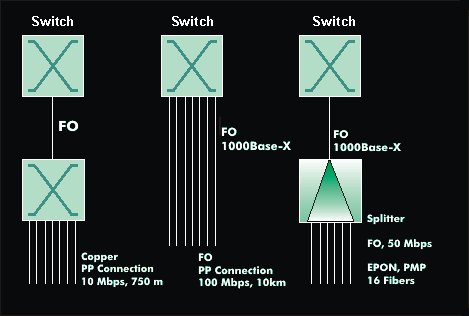EFM architecture
For Ethernet in the First Mile( EFM), there are three architectures being developed by working groups: Point-to-Multipoint( PMP, P2MP) over fiber( EPON), Point-to-Point( PP, P2P) over fiber, and over copper cable. In addition, there is a working group for management functions: Operation, Administration, and Maintenance( OAM).
The point-to-multipoint link over fiber distributes information in broadcast to all subscribers from a Central Office( CO). The return channel from the subscriber to the Central Office operates in multiplex, with time slots provided to each subscriber for transmission.
A single mode fiber is used as the transmission medium, with the upstream and downstream operating in wavelength division multiplex at wavelengths of 1,270nm and 1,360nm. The physics is realized by a technique called 1000Base-PX, where PX stands for passive. Two methods are offered: 1000Base-PX10 for distances up to 10 km and 1000Base-PX20 for 20 km. The transmission rate is 1 Gbit/s. It should be possible to supply at least 16 subscribers. The P2MP connection corresponds to the standardized Ethernet Passive Optical Network (EPON).
The P2P connection via fiber and copper
The point-to-point connection on optical fiber (P2PoF, Point to Point over Fiber) uses Ethernet technology in the core area with 10 Gigabit Ethernet (10GBase-X), Fast Ethernet is used in the end area and a bidirectional method similar to EPON is used in the connection area, the area between the residential gateway and the access switch. The bridgeable distance in the access area is 10 km. Four different techniques are implemented: 100/1000Base-LX10 and 100/1000Base-BX10. LX10 uses two optical fibers, while BX10 works with wavelength division multiplexing and only one monomode fiber. These technologies can be used in conjunction with Fiber to the Home( FTTH) and Fiber to the Curb( FTTC).
In the case of the point-to-point connection over copper (P2PoC, Point to Point over Copper), the bridgeable distance is approx. 750 m. The distance between the two points can be bridged. The transmission medium is a simple category 1 telephone cable on which the send and receive data are to be transmitted bidirectionally. However, there is no realistic solution for this technology. For the realization of this technology, the working group had decided in favor of VDSL, but later revised this decision in favor of Dynamic Synchronous Transfer Mode( DTM). This cleared the way for 10PASS- TS, a passband technology with which 10 Mbit/s can be transmitted over 750 m on copper twisted pairs. For greater distances of up to 2.7 km and a data rate of 2 Mbit/s, 2Base- TL was defined with Single Pair High Bit Rate Digital Subscriber Line( SHDSL).


